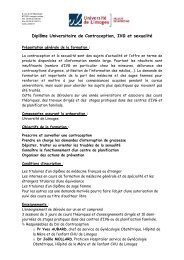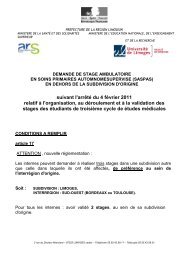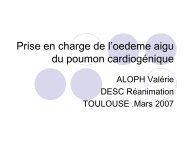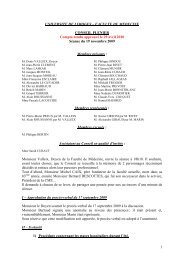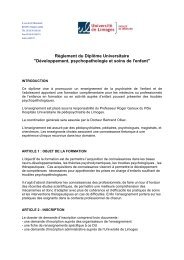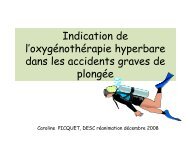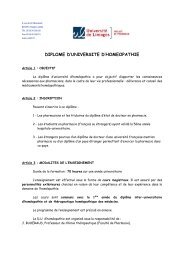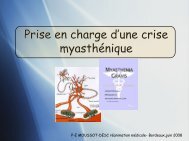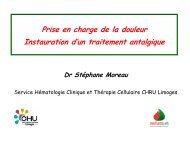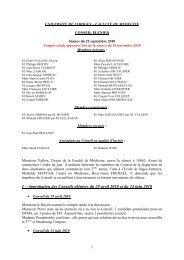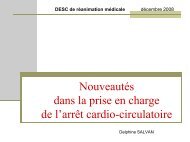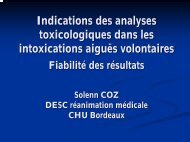Recommandations de l'ASPN pour la nutrition en réanimation
Recommandations de l'ASPN pour la nutrition en réanimation
Recommandations de l'ASPN pour la nutrition en réanimation
Create successful ePaper yourself
Turn your PDF publications into a flip-book with our unique Google optimized e-Paper software.
Gui<strong>de</strong>lines for the Provision andAssessm<strong>en</strong>t of Nutrition Support Therapy inthe Adult Critically Ill Pati<strong>en</strong>tSociety of Critical Care Medicine (SCCM) and AmericanSociety for Par<strong>en</strong>teral and Enteral Nutrition (A.S.P.E.N.)J Par<strong>en</strong>ter Enteral Nutr 2009; 33;277Steph<strong>en</strong> A. McC<strong>la</strong>ve, MD, Robert G. Martindale, MD, PhD, Vinc<strong>en</strong>t W. Vanek, MD,Mary McCarthy, RN, PhD, Pame<strong>la</strong> Roberts, MD, Beth Taylor, RD, Juan B. Ochoa,MD, L<strong>en</strong>a Napolitano, MD, Gail Cresci, RD, the A.S.P.E.N. Board of Directors andthe American College of Critical Care Medicine
Gui<strong>de</strong>lines• Experts <strong>de</strong> <strong>la</strong> SCCM et ASPEN• Source : Données <strong>de</strong> <strong>la</strong> littérature– Essais prospectifs contrôlés randomisés +++• Limites:– Réanimation chirurgicale– Popu<strong>la</strong>tion hétérogène– Manque <strong>de</strong> pouvoir statistique• <strong>Recommandations</strong> établies selon niveau <strong>de</strong> preuve
P<strong>la</strong>n• Intérêt <strong>de</strong> <strong>la</strong> <strong>nutrition</strong> <strong>en</strong> contexte d’agression• Nutrition <strong>en</strong>térale (NE) > par<strong>en</strong>térale (NP)• Dé<strong>la</strong>i <strong>de</strong> mise <strong>en</strong> p<strong>la</strong>ce• Besoins caloriques et protidiques• Tolérance <strong>de</strong> <strong>la</strong> <strong>nutrition</strong> <strong>en</strong>térale• Immuno<strong>nutrition</strong>
Objectifs <strong>de</strong> <strong>la</strong> <strong>nutrition</strong>• Contexte <strong>de</strong> <strong>réanimation</strong> : état d’hypercatabolisme• Phase aigue (état <strong>de</strong> choc) : Contre-indication à <strong>la</strong>Nutrition <strong>en</strong>téralehydrates <strong>de</strong> carbone +++• Phase anabolique (correction <strong>de</strong> l’hypoprotidémie,reconstitution <strong>de</strong>s réserves…) intérêt <strong>de</strong> <strong>la</strong> <strong>nutrition</strong> +++– Assurer les substrats ess<strong>en</strong>tiels nécessaires au fonctionnem<strong>en</strong>t<strong>de</strong>s principales voies métaboliques– Stimuler l’immunité– Maint<strong>en</strong>ir <strong>la</strong> trophicité du tube digestif
Nutrition <strong>en</strong>térale• Voie <strong>de</strong> choix +++• Entérale versus Par<strong>en</strong>térale ?– Méta-analyse <strong>de</strong> Hey<strong>la</strong>nd [1]• Six essais randomisés (498 pati<strong>en</strong>ts)• Réduction <strong>de</strong>s complications infectieuses– 24 % d’infections contre 43% (RR= 0,61 [IC 95%0,44-0,84])• Pas <strong>de</strong> réduction prouvée <strong>de</strong> <strong>la</strong> mortalité[1] Hey<strong>la</strong>nd DK.JPEN 2003; 27:355
Dé<strong>la</strong>i <strong>de</strong> mise <strong>en</strong> p<strong>la</strong>ce• Le plus tôt possible = dans les 48 premièresheures– Méta-analyse <strong>de</strong> Marik [2]• Diminution du risque infectieux (RR=0,45;95% CI 0,30-0,66;p=.00006)• T<strong>en</strong>dance à <strong>la</strong> diminution <strong>de</strong> <strong>la</strong> durée d’hospitalisation– Méta-analyse <strong>de</strong> Hey<strong>la</strong>nd [1]• T<strong>en</strong>dance à <strong>la</strong> diminution du risque infectieux (RR=0,66;95%CI 0,36-1,22; p=0,08)• T<strong>en</strong>dance à <strong>la</strong> diminution <strong>de</strong> <strong>la</strong> mortalité (RR=0,52;95% CI0,25-1,08; p=0,08)[1] Hey<strong>la</strong>nd DK.JPEN 2003; 27:355[2] Marick PE. Crit Care Med 2001;29:2264
Nutrition par<strong>en</strong>térale (1)• Sujet <strong>de</strong> controverse• Abs<strong>en</strong>ce <strong>de</strong> diminution voire augm<strong>en</strong>tation <strong>de</strong>scomplications infectieuses– Braunschweig et al [3]• diminution <strong>de</strong>s infections chez les pati<strong>en</strong>ts ne recevant pas<strong>de</strong> NP (RR= 0,77 [IC 95%0,65-0,91;p
Nutrition par<strong>en</strong>térale (2)• Alternative <strong>en</strong> cas <strong>de</strong> contre-indication oud’intolérance à <strong>la</strong> NE– Sandstrom et al.[5]• Au <strong>de</strong>là du 14ème jour d’hospitalisation• Augm<strong>en</strong>tation du taux d’infection dans le groupe non nourriversus NP (21% vs 2%, p
Evaluation <strong>de</strong>s besoins (1)• Estimation <strong>de</strong> l’état <strong>nutrition</strong>nel <strong>de</strong> base– Marqueurs biologiques non fiables <strong>en</strong> contexted’agression–BMI• BMI 30 : considérer le BMI idéal avec un facteur<strong>de</strong> correction (1,1 x BMI idéal)• Protéines: 1,2 à 2 g/kg/j
Réalité <strong>de</strong>s apports• Les objectifs caloriques sont rarem<strong>en</strong>t atteints[6,7]– Seulem<strong>en</strong>t 50 % <strong>de</strong> l’objectif initial !!!• Sous estimation <strong>de</strong>s besoins• Interruptions fréqu<strong>en</strong>tes <strong>de</strong> <strong>la</strong> <strong>nutrition</strong>• Tolérance (
Niveau <strong>de</strong> recommandationGra<strong>de</strong> of recomm<strong>en</strong>dationA Supported by at least two level I investigationsB Supported by one level I investigationC Supported by level II investigations onlyD Supported by at least two level III investigationsE Supported by level IV or level V evi<strong>de</strong>nceLevel of evi<strong>de</strong>nceI Large, randomized trials with clear-cut results; low risk of false positive(alpha) error or false-negative (beta) errorII Small, randomized trials with uncertain results; mo<strong>de</strong>rate to high risk offalse-positive (alpha) and/or false-negative (beta) errorIII Nonrandomized, contemporaneous controlsIV Nonrandomized, historical controlsV Case series, uncontrolled studies, and expert opinion
<strong>Recommandations</strong> (1)• Pour le pati<strong>en</strong>t <strong>de</strong> <strong>réanimation</strong> chirurgicale stable, neprés<strong>en</strong>tant pas <strong>de</strong> Contre-indication à <strong>la</strong> NENE précoce (dans les 48H)Gra<strong>de</strong> B• Pour le pati<strong>en</strong>t <strong>de</strong> <strong>réanimation</strong> médicale stable, neprés<strong>en</strong>tant pas <strong>de</strong> Contre-indication à <strong>la</strong> NENE précoce (dans les 48H)Gra<strong>de</strong> C• Pour le pati<strong>en</strong>t <strong>de</strong> <strong>réanimation</strong> avec Contre-indication à<strong>la</strong> NE et dé<strong>nutrition</strong>Nutrition par<strong>en</strong>térale Gra<strong>de</strong> C
<strong>Recommandations</strong> (2)• Pour le pati<strong>en</strong>t <strong>de</strong> <strong>réanimation</strong> avec Contre-indication à<strong>la</strong> NE et non dénutriAbs<strong>en</strong>ce <strong>de</strong> <strong>nutrition</strong> par<strong>en</strong>térale ( à discuter si<strong>la</strong> pério<strong>de</strong> <strong>de</strong> jeûne dépasse 1 sem)Gra<strong>de</strong> A• Pour le pati<strong>en</strong>t standart : débuter avec un objectif <strong>de</strong> 18Kcal/Kg/j et 1,5 g <strong>de</strong> protéines/kg/j <strong>la</strong> première semaineet augm<strong>en</strong>ter à 25 Kcal/Kg/j.Si à 10 j, l’objectif n’est pas atteint :Discuter <strong>nutrition</strong> par<strong>en</strong>térale associéeGra<strong>de</strong> E
Tolérance• L’abs<strong>en</strong>ce <strong>de</strong> bruits hydroaériques, témoin d’un certain<strong>de</strong>gré d’iléus ne contre-indique pas <strong>la</strong> mise <strong>en</strong> route <strong>de</strong><strong>la</strong> NEGra<strong>de</strong> E• Il n’y a pas d’indication à stopper <strong>la</strong> NE <strong>pour</strong> un volumerésiduel gastrique inférieur à 500 mLGra<strong>de</strong> B• Des mesures doiv<strong>en</strong>t être employés <strong>pour</strong> éviter lesinha<strong>la</strong>tions <strong>en</strong> cas <strong>de</strong> NE– Proclive 45°– Administration continue > fractionnée– Ag<strong>en</strong>ts pharmaceutiques prokinétiques (erythromycine,métocloprami<strong>de</strong>)Gra<strong>de</strong> CGra<strong>de</strong> DGra<strong>de</strong> C
Immuno<strong>nutrition</strong> (1)• Glutamine–NE–NP• Abs<strong>en</strong>ce d’effet sur <strong>la</strong> mortalité [10]• T<strong>en</strong>dance à réduction du taux d’infection (nonstatistiquem<strong>en</strong>t significatif)• Effet antioxydant• Diminution significative <strong>de</strong> <strong>la</strong> mortalité [11]NONRECOMMANDEEGra<strong>de</strong> C• Ornithine ketoglutarate• Abs<strong>en</strong>ce d’efficacité démontréé [12][10] Buchman AL. Am J Clin Nutr 2001;74:25[11] Hey<strong>la</strong>nd DK. JPEN 2003;27:355-373[12] see Http://www.criticalcare<strong>nutrition</strong>.com march 3, 2009)NONRECOMMANDEE
Immuno<strong>nutrition</strong> (2)• Arginine• Réduction non significative aussi bi<strong>en</strong> <strong>de</strong><strong>la</strong> mortalité que <strong>de</strong>s infections [11]• Vitamines et oligoélém<strong>en</strong>ts• Réduction <strong>de</strong> <strong>la</strong> mortalité [13]NONRECOMMANDEEGra<strong>de</strong> B• Oméga 3• NE <strong>en</strong>richie <strong>en</strong> oméga 3 <strong>pour</strong> SDRA / ALI• Diminution durée VM et hospitalisation [14]Gra<strong>de</strong> A• ProbiotiquesNONRECOMMANDEE[13] Hey<strong>la</strong>nd DK. Int<strong>en</strong>sive Care Med. 2005;31:327-337[14] Pontes Arruda A. Crit Care Med. 2006;34:2325-2333
Conclusion• Nutrition <strong>en</strong>térale précoce +++• Intérêt <strong>de</strong> respecter les objectifscaloriques fixés• Nutrition par<strong>en</strong>térale réservée aux casparticuliers• P<strong>la</strong>ce <strong>de</strong> l’immuno<strong>nutrition</strong> ?



